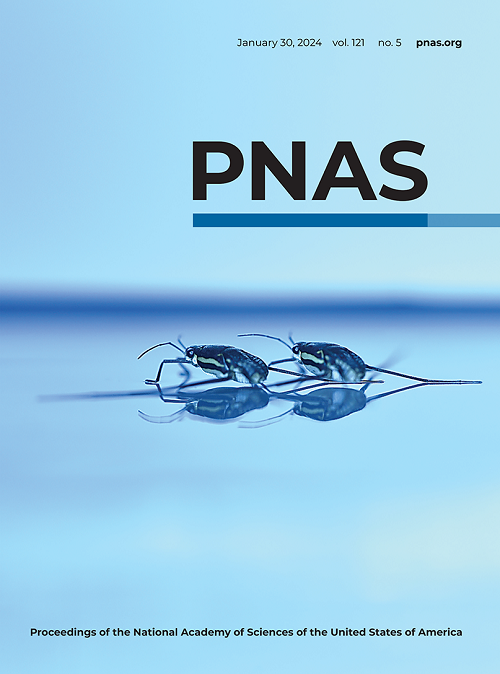果糖-2,6-二磷酸可恢复 PNKP 的 DNA 修复活性并改善亨廷顿氏病的神经退行性症状
IF 9.4
1区 综合性期刊
Q1 MULTIDISCIPLINARY SCIENCES
Proceedings of the National Academy of Sciences of the United States of America
Pub Date : 2024-09-19
DOI:10.1073/pnas.2406308121
引用次数: 0
摘要
亨廷顿氏病(Huntington's disease,HD)和脊髓小脑共济失调 3 型(spinocerebellar ataxia type 3,SCA3)是两种最常见的多谷氨酰胺(polyQ)神经退行性疾病,分别由亨廷廷蛋白(huntingtin,HTT)和共济失调蛋白 3(ataxin-3,ATXN3)编码区的 CAG(编码谷氨酰胺)重复扩增引起。我们早前曾报道,在 HD 和 SCA3 中,一种重要的 DNA 修复酶--多核苷酸激酶 3′-磷酸酶(PNKP)的活性(而非蛋白质水平)被严重削弱,导致患者大脑基因组中双链断裂的积累。在研究 PNKP 活性丧失和 DNA 双链断裂积累导致神经元死亡的机理基础时,我们观察到 PNKP 与 6-磷酸果糖-2-激酶果糖-2,6-二磷酸酶 3(PFKFB3)的核异构体相互作用。在不改变 PNKP 蛋白水平的情况下,消耗 PFKFB3 会明显削弱 PNKP 的活性。值得注意的是,在 HD 和 SCA3 患者死后脑组织的核提取物中,PFKFB3 及其产物果糖-2,6-二磷酸(F2,6BP)(一种糖酵解的异构调节剂)的水平均显著降低。补充 F2,6BP 可恢复患者脑组织核提取物中 PNKP 的活性。此外,细胞内输送 F2,6BP 还能恢复 PNKP 的活性以及 HD 小鼠纹状体神经元细胞中转录基因组的完整性。重要的是,补充 F2,6BP 能挽救果蝇的 HD 表型,这表明 F2,6BP 在体内可作为 PNKP 正常功能的辅助因子,从而促进大脑健康。因此,我们的研究结果为探索 F2,6BP 及其结构相关化合物治疗多 Q 疾病提供了令人信服的理由。本文章由计算机程序翻译,如有差异,请以英文原文为准。
Fructose-2,6-bisphosphate restores DNA repair activity of PNKP and ameliorates neurodegenerative symptoms in Huntington’s disease
Huntington’s disease (HD) and spinocerebellar ataxia type 3 (SCA3) are the two most prevalent polyglutamine (polyQ) neurodegenerative diseases, caused by CAG (encoding glutamine) repeat expansion in the coding region of the huntingtin (HTT) and ataxin-3 (ATXN3) proteins, respectively. We have earlier reported that the activity, but not the protein level, of an essential DNA repair enzyme, polynucleotide kinase 3′-phosphatase (PNKP), is severely abrogated in both HD and SCA3 resulting in accumulation of double-strand breaks in patients’ brain genome. While investigating the mechanistic basis for the loss of PNKP activity and accumulation of DNA double-strand breaks leading to neuronal death, we observed that PNKP interacts with the nuclear isoform of 6-phosphofructo-2-kinase fructose-2,6-bisphosphatase 3 (PFKFB3). Depletion of PFKFB3 markedly abrogates PNKP activity without changing its protein level. Notably, the levels of both PFKFB3 and its product fructose-2,6 bisphosphate (F2,6BP), an allosteric modulator of glycolysis, are significantly lower in the nuclear extracts of postmortem brain tissues of HD and SCA3 patients. Supplementation of F2,6BP restored PNKP activity in the nuclear extracts of patients’ brain. Moreover, intracellular delivery of F2,6BP restored both the activity of PNKP and the integrity of transcribed genome in neuronal cells derived from the striatum of the HD mouse. Importantly, supplementing F2,6BP rescued the HD phenotype in Drosophila, suggesting F2,6BP to serve in vivo as a cofactor for the proper functionality of PNKP and thereby, of brain health. Our results thus provide a compelling rationale for exploring the therapeutic use of F2,6BP and structurally related compounds for treating polyQ diseases.
求助全文
通过发布文献求助,成功后即可免费获取论文全文。
去求助
来源期刊
CiteScore
19.00
自引率
0.90%
发文量
3575
审稿时长
2.5 months
期刊介绍:
The Proceedings of the National Academy of Sciences (PNAS), a peer-reviewed journal of the National Academy of Sciences (NAS), serves as an authoritative source for high-impact, original research across the biological, physical, and social sciences. With a global scope, the journal welcomes submissions from researchers worldwide, making it an inclusive platform for advancing scientific knowledge.

 求助内容:
求助内容: 应助结果提醒方式:
应助结果提醒方式:


